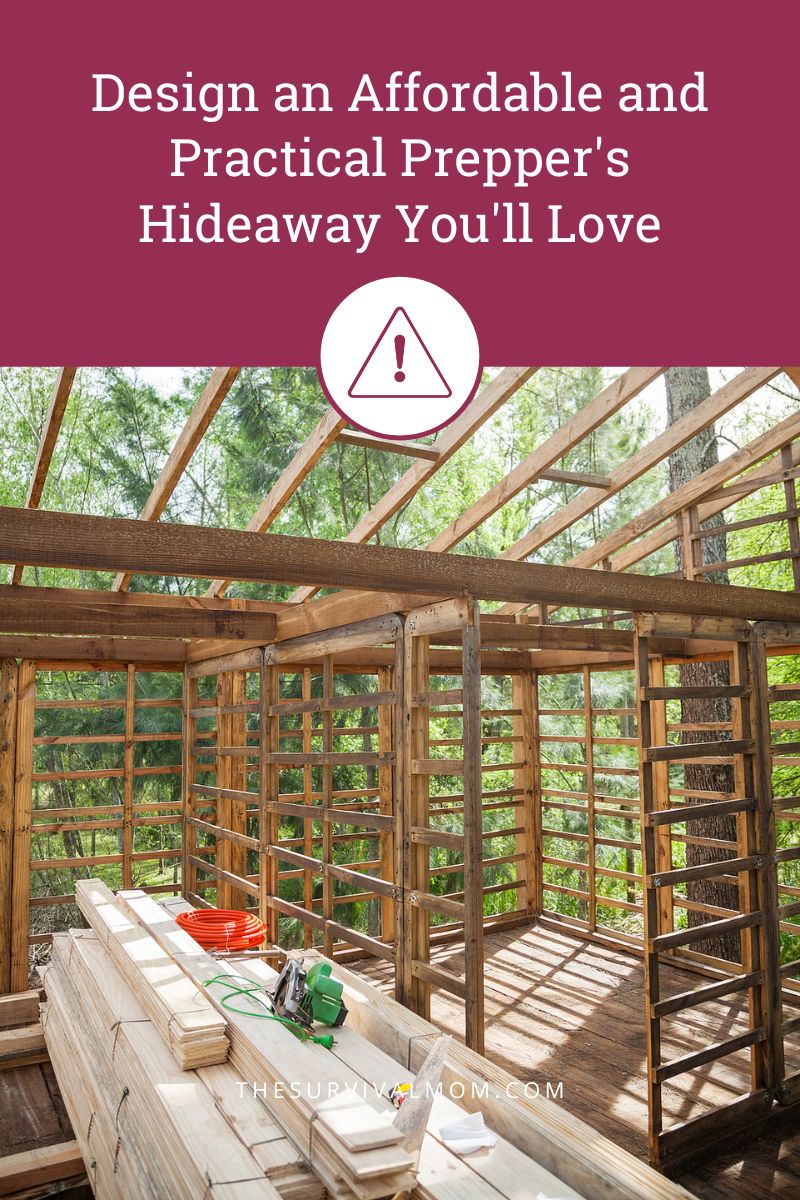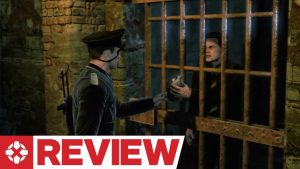Some of the links in this post may contain affiliate links for your convenience. As an Amazon associate I earn from qualifying purchases.
Designing a house should be fun! It’s a chance to for your dreams to become real in the form of a home. Most of us don’t get to include all the bells and whistles we might like. However, we can include the most important ones, leaving the possibility to add more, later. At the very least, when you design your own preppers hideaway, you can avoid things you truly dislike. Here are things to do:
Buying Property
Are you still working on finding a piece of property? Go read the post Picking an Affordable & Usable Property for Getting Out of Dodge. The come back here.
The Perc Test
The very first step to take before buying land is to have a perc test done, if one hasn’t been done already. If it fails, no home can be built on the property; just walk away and find a different location, unless you want a lot of extra hassle and potential difficulty reselling the land. (There are options that allow some of this land to be built on, but it’s more complicated, potentially expensive, and can be harder to maintain.)
The perc test tells how large the septic drain field can be. That, in turn, lets you know how large your house can be. The result will be something along the lines of, “This property perked for three bedrooms”, which means you can build a three bedroom house, but not a four bedroom house. That’s not a suggestion and you can’t ignore it. If your lot perks for three bedrooms and you need four, then you will need to buy an additional piece of adjoining land that perks for at least one bedroom and combine the two to build a four bedroom house.
Even if you don’t plan on building a full-size house and only plan to camp on your new land, you really should at least do a perc test for the sake of future resale value.
The very first step to take before buying land is to have a perc test done
This video explains a perc test.
Plan Ahead for Off-Grid
Some areas support geo-thermal heating, solar panels, wind turbines, and other off-grid technology. If you are wanting, or hoping, to go completely off-grid, looking for properties that lend themselves to these options, is the way to go. You don’t want to invest money in property, developing, and building, only to find out that your location doesn’t lend itself to many off-grid options. Plan for the installation and use of these alternative power sources in the earliest stages of designing and building.
If you want to be on your own well, before purchasing the property, find out if that’s even an option. One farm property we looked at was on city water. When I asked about having a well dug, the nice folks in this rural Kentucky area had never heard of such a thing. The realtor asked around to find someone who could even dig a well! That surprised me. I had assumed a homestead of 20+ acres and well beyond city limits would automatically be on its own well. So, be sure to ask about this.
Designing a Preppers Hideaway
Why did you purchase your land?
- To live on full time?
- To use for recreation?
- For a time in the future when you might want to get away from cities in a bug-out scenario?
Regardless, the first steps target getting ready to build.
Preparing Your Land
Once you buy the land, install a well and septic system if they aren’t already there. You can have the basic well and septic installed without having a final home location. However, that would be a bit unusual and require the contractors to come back out later to finish the installation and hook-up. Try to avoid that extra expense, if possible.
It’s also important to know that a fair amount of power in necessary to operate the well pump and the septic pump, so electricity will also need to be run to your property.
As mentioned in the post on choosing a property, a well and septic system costs $10,000-20,000 or more each, depending on size and complexity. Therefore, a $60,000 lot with a well and septic installed may be a bargain compared to an unimproved one the same size for $40,000.
Personally, I would buy a lot with a well and septic already installed, if that was an option. It’s just easier and there are no worries about unexpected costs in installing the well and septic. Many people have successfully dug their own wells, however.
For the well, I have heard that some areas used to regularly install little windmills over the well to power them in an emergency. It’s also possible to install a hand pump. Those both sound like fine plans to me, especially after we had our well pump go out and had no running water in our house for several days. If you have a well and septic, no well also means no toilet. That’s because you need the water from the well to refill the toilets.
Room for Expansion
Tiny houses are cool. Tiny houses are fun! Tiny houses are…tiny. However, we all have to start somewhere.
For a Get Out Of Dodge location or a weekend getaway, a tiny house is a great place to start, but that doesn’t mean you need to stop there forever. You can start with a tiny house and add on as finances allow.
Also, my view is that if a 200 square foot house is “tiny” for one person, then an 800 square foot house is still “tiny” for two adults and two teens, so “tiny” doesn’t have to mean microscopic! If you’re a DIY type of person, or family, you could possibly build your own tiny house with plans such as these.
Tiny house or not, your initial space needs to include a kitchen. Since this is typically the most expensive space to build, it makes sense to build it with future expansion in mind. For example, if your initial building is quite small, the original space eventually becomes the kitchen and dining area with a guest bathroom. To me, the easiest way to do this is to have a series of smaller spaces connected by corridors or hallways, possibly surrounding a courtyard, parking, or work area.
As your family or group grows and/or you have more money to spend, the original small Get Out of Dodge shelter grows, but in an orderly and pre-planned fashion.
I found a floor plan in the book Compact Cabins that has another great idea for connecting two parts of a home: build a greenhouse or enclosed patio in the space between them. Depending on need, this space could double as a mini-greenhouse, storage, or living space. I can easily imagine a space near the garage with pegboard walls. One is covered in tools, another filled with books and homeschooling materials, and yet another filled with herbs and veggies.
Planning with Storage in Mind
Storage is always an issue. So, another option would be to start off with a garage with a bathroom and plenty of storage space. (You may not feel this way, but I want a bathroom ASAP!) Later, a garage bathroom makes it possible to have dirty kids, dog, etc. clean off before coming into the main house. Initially, though, the large garage provides perfectly suitable living quarters. By starting with a garage, you’ll have covered and secured storage space right away.
If you are thinking of building it yourself, Cabins: A Guide to Building Your Own Nature Retreat by David Stiles, describes how to build your own cabin in the woods. It starts with site preparation and goes all the way through furniture selection.
Landscaping for Food and Security
Whether you are looking primarily for a weekend getaway or a full-on bug-out location, landscaping needs to be part of your planning to include:
- a portion of the land cleared,
- a basement may need to be dug,
- a driveway and parking created,
- and open space around your building(s) determined.
Create Space
Even if you want to keep your lot heavily forested, there still needs to be some space around your buildings. If trees are too close, three things can happen:
- the roots can damage foundations,
- limbs are more likely to drop onto the roof or otherwise damage the building,
- and critters can easily use them as a pathway onto and into your (now their) home.
Also, in areas prone to fire, this should also be large enough to provide a firebreak.
Food Forests and Edible Landscaping
Another consideration, is that you will need a rather large area for growing food. If your land is heavily forested, the shade becomes a problem. It will also make any type of solar cooking more difficult!
Most people simply plant pretty (but low-maintenance) flowers, bushes, and trees because that’s what they are used to doing. As a prepper, odds are that you want your landscaping to do more work for you. Herbs, vegetables, berry bushes, nut trees, and fruit trees come to mind, but landscaping can also camouflage your property and provides protection. Many herbs and flowers, including marigolds, provide protection from insects. Anything with thorns is a deterrent for human pests trying to break in.
Landscaping Resources for a Preppers Hideaway
There are many good books on the topic, but Rick Austin’s are particularly good. Secret Garden of Survival: How to Grow a Camouflaged Food Forest tells you how to design an edible garden that won’t be noticed by passers-by. It requires minimal human involvement, which is critical for a rarely-used getaway.
Secret Greenhouse of Survival: How to Build the Ultimate Homestead & Prepper Greenhouse is about building a greenhouse that doesn’t look like a greenhouse. Because it is designed to retain heat and help warm the house overall, the ideas are good even if you aren’t interested in a greenhouse.
Preppers Hideaway Inspirations
- Tiny houses often have little hidden compartments. If you are building a property that won’t be your primary home, at least for now, including some burglar-resistant (hidden) spaces makes sense. Even if you don’t plan on leaving a lot of belongings there, it’s still a good idea. For example, my family has lots of DVDs that we will copy onto a portable drive. Having that stolen would be irritating, and a hidey-hole would conceal it perfectly!
- Will your location be hot in the summer and cold in the winter? Then you may want to add a root or other cellar to store your temperature-sensitive medicine, electronics, and food, including basic canned goods. Take precautions in case a pipe freezes and bursts as well.
- Personally, I want to build a series of smaller buildings with corridors or breezeways connecting them. This way, we can build one small building, then add onto it as money allows and as our kids grow older. Ideally, these will eventually surround a central courtyard. This offers a lot of great flexibility and options in terms of both privacy and security. Your courtyard can be as open, or as hidden, from the outside as you choose. Spanish haciendas, with their interior courtyards, are a great example of this kind of style. They are generally one continuous building but may have several different levels, so it’s still worth taking a look. While Spanish hacienda style isn’t my first choice, it does have some great ideas for easy maintenance, comfort in the heat, and indoor-outdoor living.
- The interiors of yachts and private cars for trains are my favorite source of inspiration for space-saving interiors. The people who design these are masters at that! For example, they routinely have a small shelf above the bathroom door to hold extra toilet paper and special dish racks to keep dishes safe on bumpy rails/seas. (This also keeps dishes safe in smaller earthquakes.) Small-scale appliances designed for use in boats can be used in a tiny house as well.
- The Japanese are also renowned for their small-space designs. The home on the cover of The Very Small House has a raised floor for the kitchen. Naturally, there are segments that open to access storage under the entire kitchen floor.
- Finally, Ikea. It’s a great source of ingenious space-saving furnishings.
Designing Your Preppers Hideaway
Are you an architect? (I’m not.) Then work with a professional to turn your dreams and ideas into a buildable reality. They’ll help you design your preppers hideaway in stages, adding additional rooms and sections, as time and finances permit.
Will it be costly to hire an expert? Yes, but not nearly as costly as not having a professional make sure it’s right. Even small mistakes, such as forgetting to include a septic pipe, can be incredibly costly to fix. A professional builder should spot and fix at least the most obvious design mistakes. It’s going to take more of their time, though. You’ll end up paying at one end or the other!
Will it be costly to hire an expert? Yes, but not nearly as costly as not having a professional make sure it’s right.
So why bother going through all this process? An architect is a professional, but not a mind-reader. The more clearly you can articulate what you want, the easier (and possibly more fun) their job will be. If you tell them, “I want a 1000 square foot house with 2 bedrooms and 2 bathrooms”, then you might as well look through a book of pre-made plans and pick one out. You have given them nothing to work with.
If you say, “We want a lake house that brings to mind The Great Gatsby with a lot of yacht-inspired details, passive heating and cooling, and the lot perked for 3 bedrooms”, they have a real direction to go with their design. Creating a Pinterest board is a great way to show an architect or designer what you love (or hate).
I’m excited to design and build a preppers hideaway for my family – even if we only need to “hide away” every so often from the routine drudgery of school and work!
Final Thoughts on Designing a Prepper Hideout
Constructing an affordable prepper’s hideaway is not only possible but also rewarding. By combining smart design choices, budget-conscious strategies, and practical solutions, you can create a save haven without breaking the bank. Remember, preparedness is about resourcefulness. With the right approach, you can craft a retreat that offers peace of mind during uncertain times.
What features would you want in your preppers hideaway?
Originally published July 19, 2016.
















